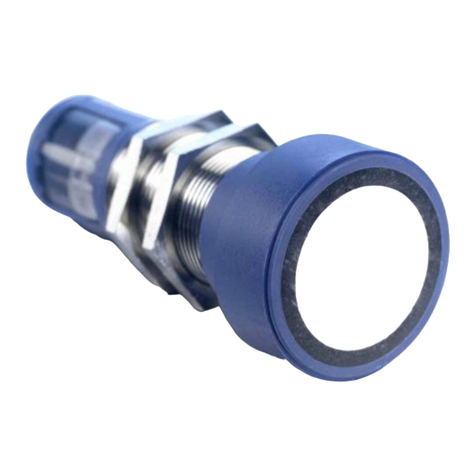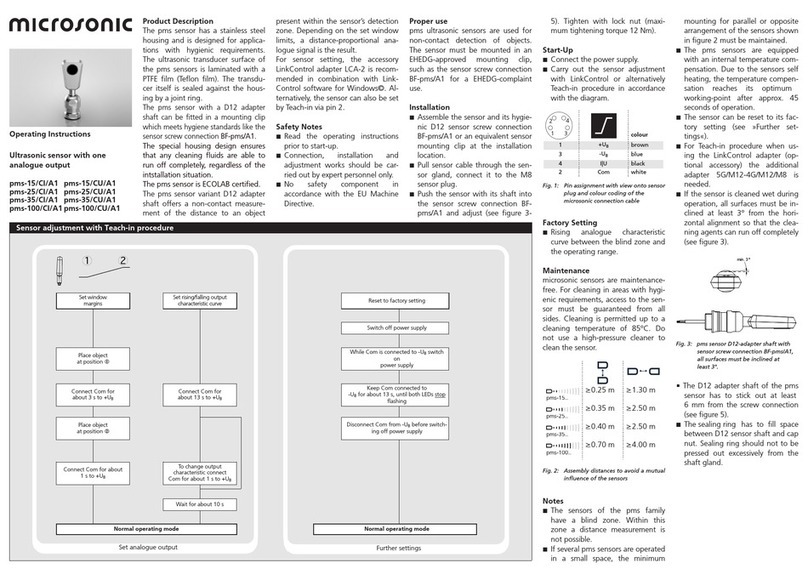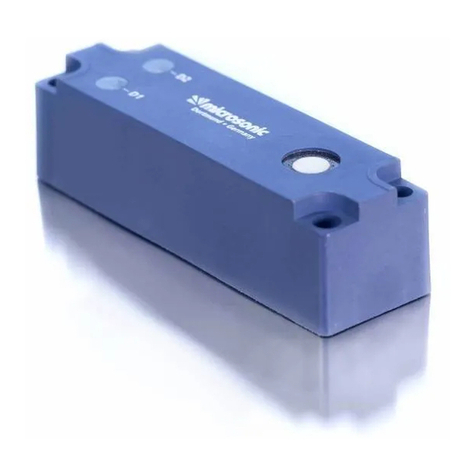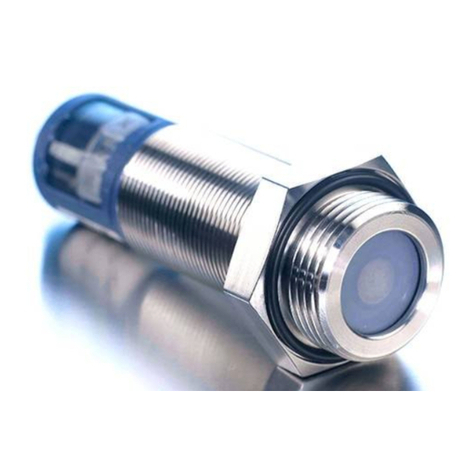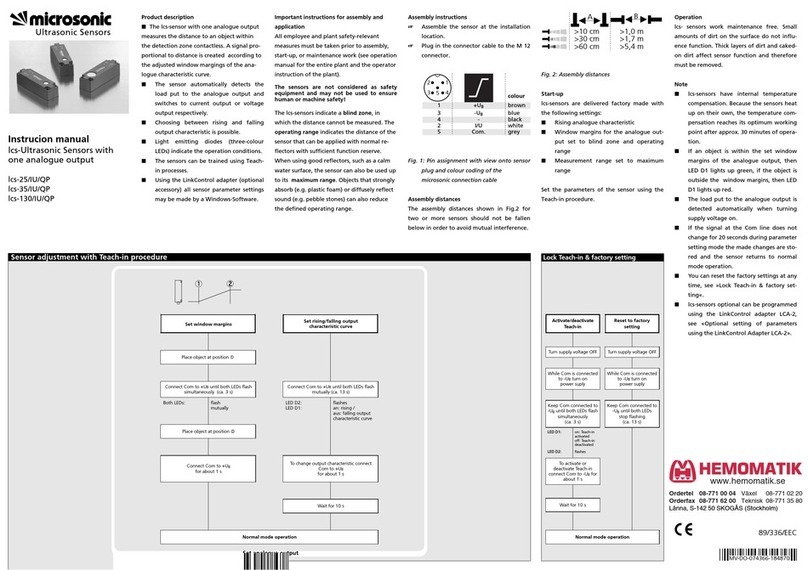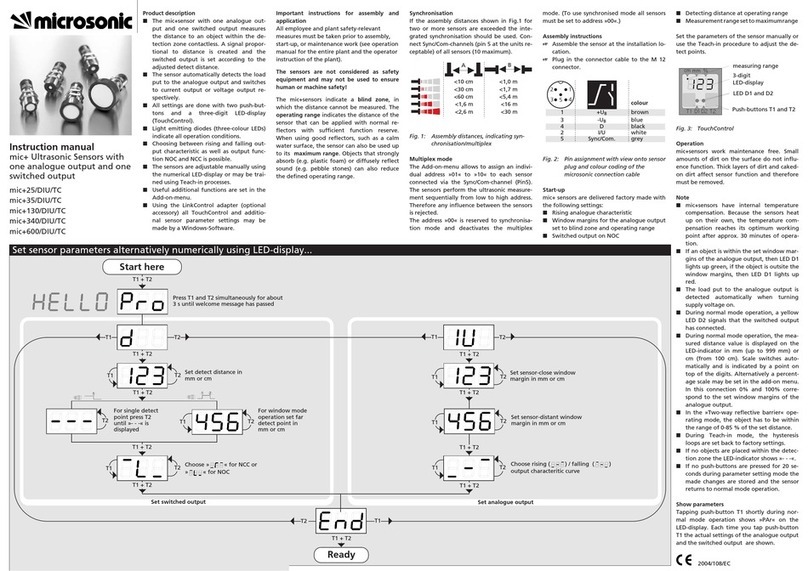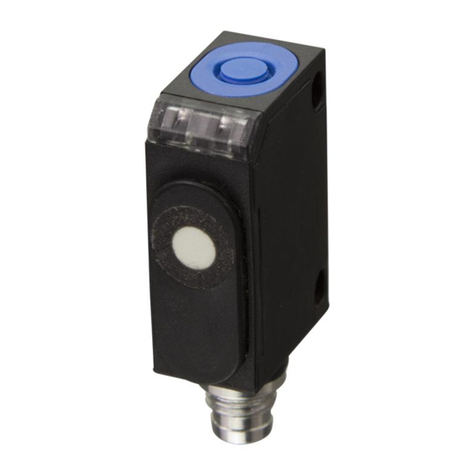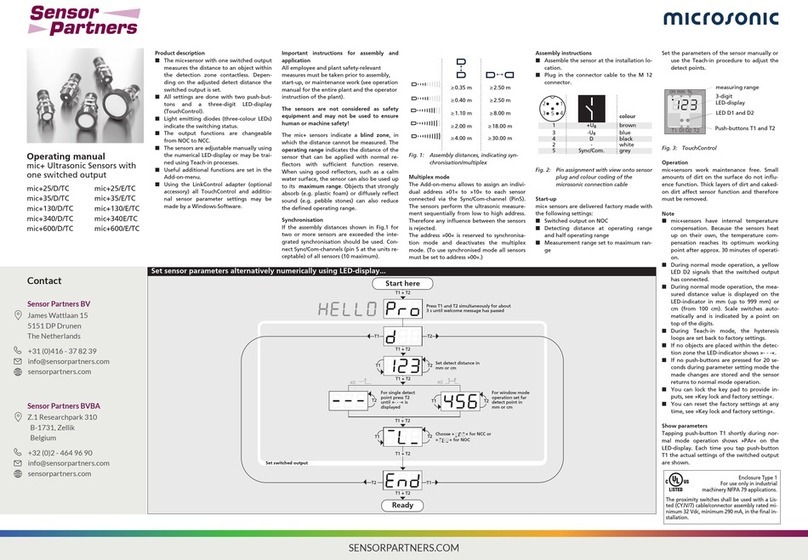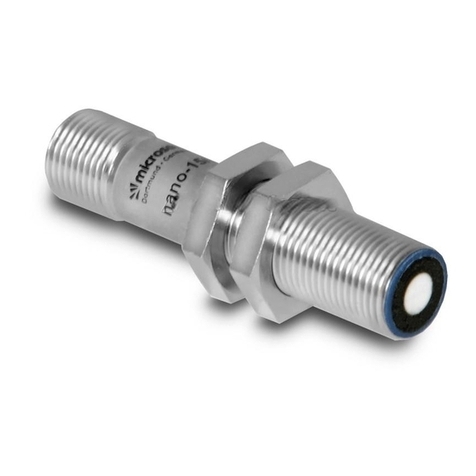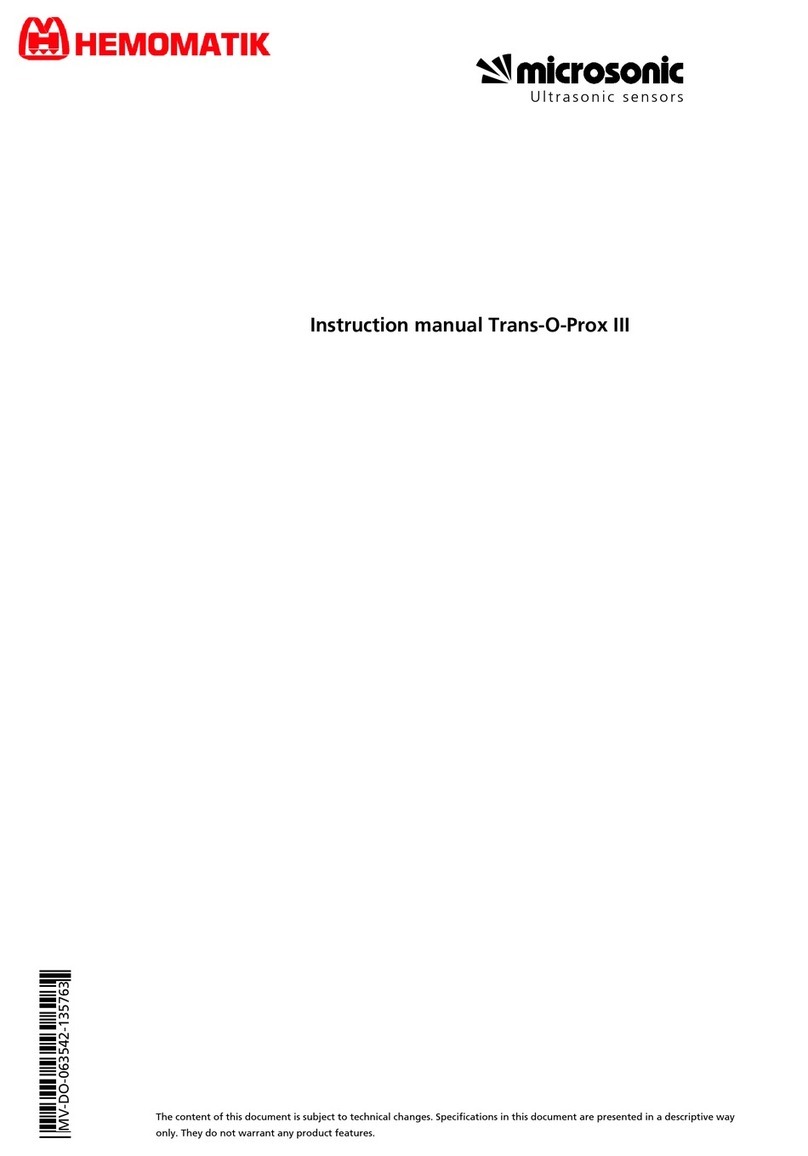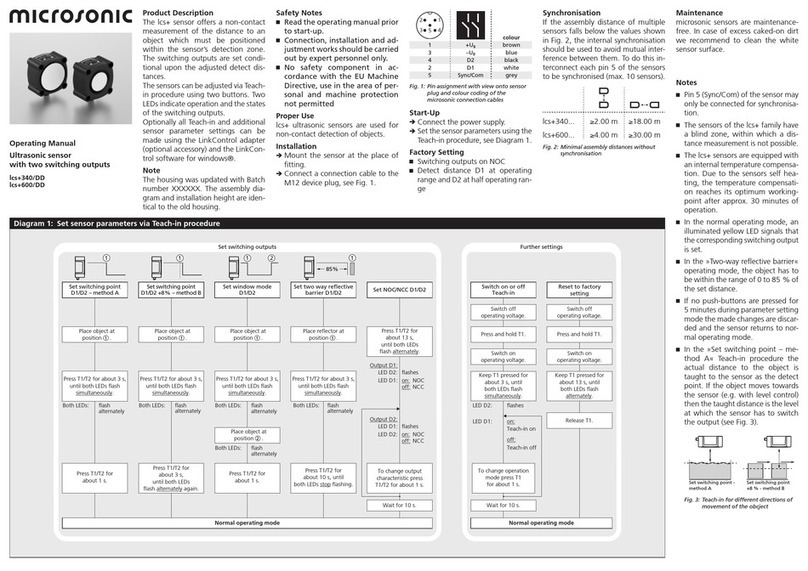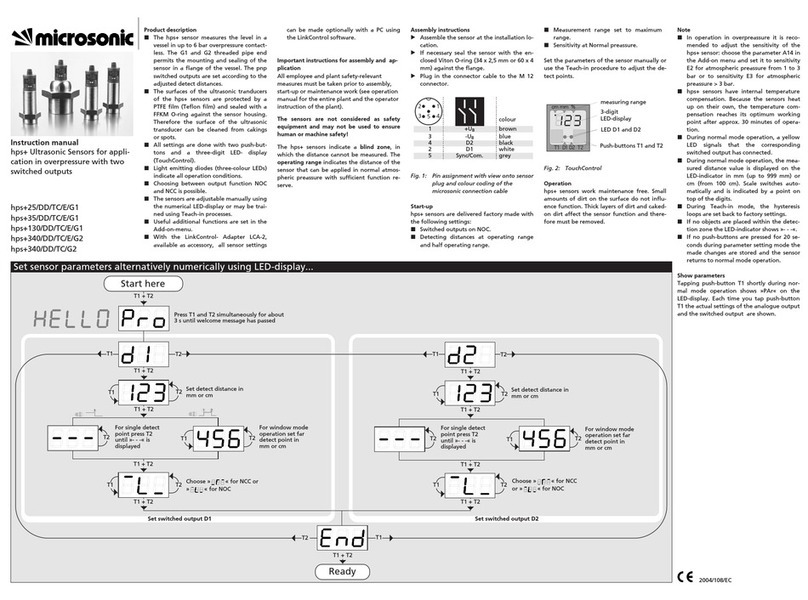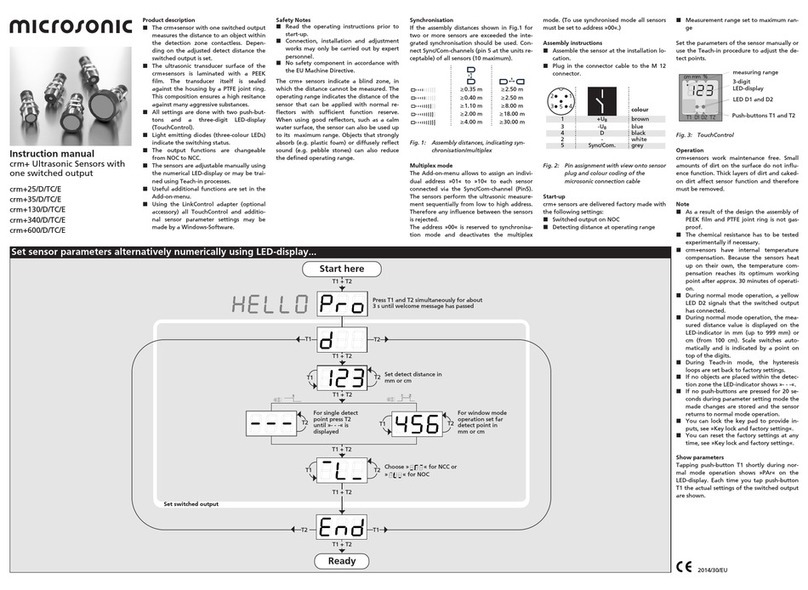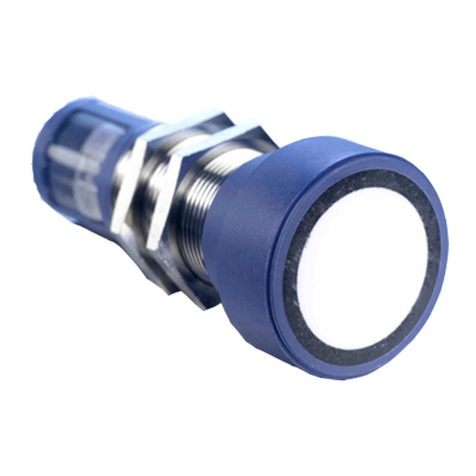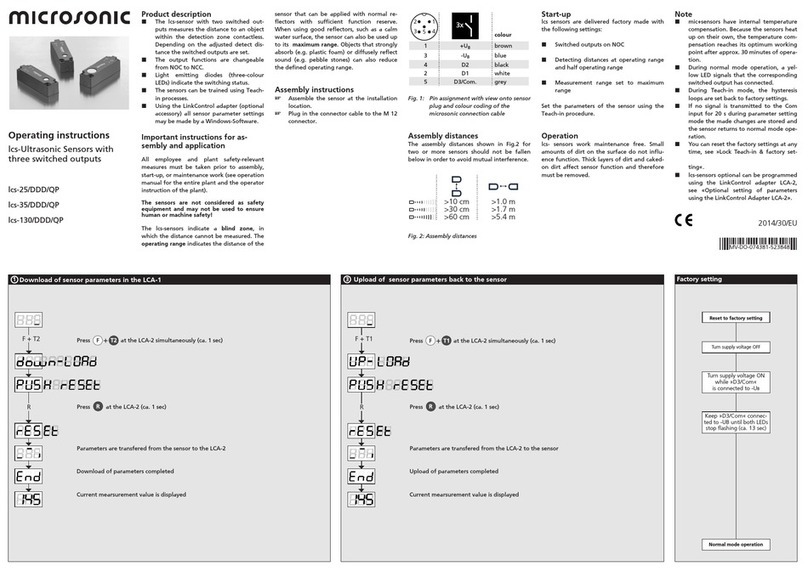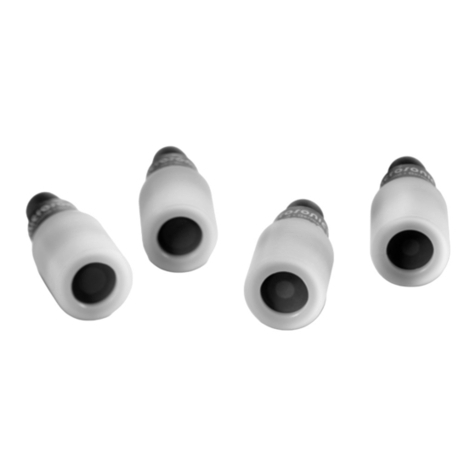
SENSORPARTNERS.COM
Instrucion manual
lcs-Ultrasonic Sensors with
one analogue output
lcs-25/IU/QP
lcs-35/IU/QP
lcs-130/IU/QP
Product description
The lcs-sensor with one analogue out-
put measures the distance to an object
within the detection zone contactless. A
signal proportional to distance is cre-
ated according to the adjusted window
margings of the analogue characteristic
curve.
The sensor automatically detects the
load put to the analogue output and
switches to current output or voltage
output respectively.
Choosing between rising and falling
output characteristic is possible.
Light emitting diodes (three-colour
LEDs) indicate the operation conditions.
The sensors can be trained using Teach-
in processes.
Using the LinkControl adapter (optional
accessory) all sensor parameter settings
may be made by a Windows-Software.
Important instructions for assembly and
application
All employee and plant safety-relevant
measures must be taken prior to assembly,
start-up, or maintenance work (see operation
manual for the entire plant and the operator
instruction of the plant).
The sensors are not considered as safety
equipment and may not be used to ensure
human or machine safety!
The lcs-sensors indicate a blind zone, in
which the distance cannot be measured. The
operating range indicates the distance of the
sensor that can be applied with normal re-
flectors with sufficient function reserve.
When using good reflectors, such as a calm
water surface, the sensor can also be used up
to its maximum range. Objects that strongly
absorb (e.g. plastic foam) or diffusely reflect
sound (e.g. pebble stones) can also reduce
the defined operating range.
Assembly instructions
Assemble the sensor at the installation
location.
Plug in the connector cable to the M12
connector.
Fig. 1: Pin assignment with view onto sensor
plug and colour coding of the
microsonic connection cable
Assembly distances
The assembly distances shown in Fig.2 for
two or more sensors should not be fallen
below in order to avoid mutual interference.
brown
blue
4
2
5
-
I/U
black
white
Com. grey
Fig. 2: Assembly distances
Start-up
lcs-sensors are delivered factory made with
the following settings:
Rising analogue characteristic
Window margins for the analogue out-
put set to blind zone and operating
range
Measurement range set to maximum
range
Set the parameters of the sensor using the
Teach-in procedure.
≥0.25 m
≥0.35 m
≥1.30 m
≥2.50 m
≥1.10 m ≥8.00 m
Operation
lcs-sensors work maintenance free. Small
amounts of dirt on the surface do not influ-
ence function. Thick layers of dirt and caked-
on dirt affect sensor function and therefore
must be removed.
Note
lcs-sensors have internal temperature
compensation. Because the sensors heat
up on their own, the temperature com-
pensation reaches its optimum working
point after approx. 30 minutes of opera-
tion.
If an object is within the set window
margins of the analogue output, then
LED D1 lights up green, if the object is
outside the window margins, then LED
D1 lights up red.
The load put to the analogue output is
detected automatically when turning
supply voltage on.
If the signal at the Com line does not
change for 20 seconds during parameter
setting mode the made changes are sto-
red and the sensor returns to normal
mode operation.
You can reset the factory settings at any
time, see »Lock Teach-in & factory set-
ting«.
lcs-sensors optional can be programmed
using the LinkControl adapter LCA-2,
see «Optional setting of parameters
using the LinkControl Adapter LCA-2».
MV-DO-074366-595316
2014/30/EU
Lock Teach-in & factory setting
Activate/deactivate
Teach-in
While Com is connected
to -UBturn on
power suply
While Com is connected
to -UBturn on
power suply
Keep Com connected to
-UBuntil both LEDs flash
simultaneously
(ca. 3 s)
on: Teach-in
activated
off: Teach-in
deactivated
To activate or
deactivate Teach-in
connect Com to -UBfor
about 1 s
Keep Com connected to
-UBuntil both LEDs
stop flashing
(ca. 13 s)
Sensor adjustment with Teach-in procedure
Place object at position
Set rising/falling output
characteristic curve
Connect Com to +UBuntil both LEDs flash
simultaneously (ca. 3 s)
Place object at position
Connect Com to +UB
for about 1 s
Connect Com to +UBuntil both LEDs flash
mutually (ca. 13 s)
flashes
an: rising /
aus: falling output
characteristic curve
To change output characteristic connect
Com to +UB
for about 1 s
Instrucion manual
lcs-Ultrasonic Sensors with
one analogue output
lcs-25/IU/QP
lcs-35/IU/QP
lcs-130/IU/QP
Product description
The lcs-sensor with one analogue out-
put measures the distance to an object
within the detection zone contactless. A
signal proportional to distance is cre-
ated according to the adjusted window
margings of the analogue characteristic
curve.
The sensor automatically detects the
load put to the analogue output and
switches to current output or voltage
output respectively.
Choosing between rising and falling
output characteristic is possible.
Light emitting diodes (three-colour
LEDs) indicate the operation conditions.
The sensors can be trained using Teach-
in processes.
Using the LinkControl adapter (optional
accessory) all sensor parameter settings
may be made by a Windows-Software.
Important instructions for assembly and
application
All employee and plant safety-relevant
measures must be taken prior to assembly,
start-up, or maintenance work (see operation
manual for the entire plant and the operator
instruction of the plant).
The sensors are not considered as safety
equipment and may not be used to ensure
human or machine safety!
The lcs-sensors indicate a blind zone, in
which the distance cannot be measured. The
operating range indicates the distance of the
sensor that can be applied with normal re-
flectors with sufficient function reserve.
When using good reflectors, such as a calm
water surface, the sensor can also be used up
to its maximum range. Objects that strongly
absorb (e.g. plastic foam) or diffusely reflect
sound (e.g. pebble stones) can also reduce
the defined operating range.
Assembly instructions
Assemble the sensor at the installation
location.
Plug in the connector cable to the M12
connector.
Fig. 1: Pin assignment with view onto sensor
plug and colour coding of the
microsonic connection cable
Assembly distances
The assembly distances shown in Fig.2 for
two or more sensors should not be fallen
below in order to avoid mutual interference.
1
3
-U
brown
blue
4
2
5
-
I/U
black
white
Com. grey
1
5
2
Fig. 2: Assembly distances
Start-up
lcs-sensors are delivered factory made with
the following settings:
Rising analogue characteristic
Window margins for the analogue out-
put set to blind zone and operating
range
Measurement range set to maximum
range
Set the parameters of the sensor using the
Teach-in procedure.
≥0.25 m
≥0.35 m
≥1.30 m
≥2.50 m
≥1.10 m ≥8.00 m
Operation
lcs-sensors work maintenance free. Small
amounts of dirt on the surface do not influ-
ence function. Thick layers of dirt and caked-
on dirt affect sensor function and therefore
must be removed.
Note
lcs-sensors have internal temperature
compensation. Because the sensors heat
up on their own, the temperature com-
pensation reaches its optimum working
point after approx. 30 minutes of opera-
tion.
If an object is within the set window
margins of the analogue output, then
LED D1 lights up green, if the object is
outside the window margins, then LED
D1 lights up red.
The load put to the analogue output is
detected automatically when turning
supply voltage on.
If the signal at the Com line does not
change for 20 seconds during parameter
setting mode the made changes are sto-
red and the sensor returns to normal
mode operation.
You can reset the factory settings at any
time, see »Lock Teach-in & factory set-
ting«.
lcs-sensors optional can be programmed
using the LinkControl adapter LCA-2,
see «Optional setting of parameters
using the LinkControl Adapter LCA-2».
MV-DO-074366-595316
2014/30/EU
Lock Teach-in & factory setting
Activate/deactivate
Teach-in
While Com is connected
to -UBturn on
power suply
While Com is connected
to -UBturn on
power suply
Keep Com connected to
-UBuntil both LEDs flash
simultaneously
(ca. 3 s)
on: Teach-in
activated
off: Teach-in
deactivated
To activate or
deactivate Teach-in
connect Com to -UBfor
about 1 s
Keep Com connected to
-UBuntil both LEDs
stop flashing
(ca. 13 s)
Sensor adjustment with Teach-in procedure
Place object at position
Set rising/falling output
characteristic curve
Connect Com to +UBuntil both LEDs flash
simultaneously (ca. 3 s)
Place object at position
Connect Com to +UB
for about 1 s
Connect Com to +UBuntil both LEDs flash
mutually (ca. 13 s)
flashes
an: rising /
aus: falling output
characteristic curve
To change output characteristic connect
Com to +UB
for about 1 s
+32 (0)2 - 464 96 90
sensorpartners.com
Z.1 Researchpark 310
B-1731, Zellik
Belgium
Sensor Partners BVBA
+31 (0)416 - 37 82 39
sensorpartners.com
James Wattlaan 15
5151 DP Drunen
The Netherlands
Sensor Partners BV
Contact
Instrucion manual
lcs-Ultrasonic Sensors with
one analogue output
lcs-25/IU/QP
lcs-35/IU/QP
lcs-130/IU/QP
Product description
The lcs-sensor with one analogue out-
put measures the distance to an object
within the detection zone contactless. A
signal proportional to distance is cre-
ated according to the adjusted window
margings of the analogue characteristic
curve.
The sensor automatically detects the
load put to the analogue output and
switches to current output or voltage
output respectively.
Choosing between rising and falling
output characteristic is possible.
Light emitting diodes (three-colour
LEDs) indicate the operation conditions.
The sensors can be trained using Teach-
in processes.
Using the LinkControl adapter (optional
accessory) all sensor parameter settings
may be made by a Windows-Software.
Important instructions for assembly and
application
All employee and plant safety-relevant
measures must be taken prior to assembly,
start-up, or maintenance work (see operation
manual for the entire plant and the operator
instruction of the plant).
The sensors are not considered as safety
equipment and may not be used to ensure
human or machine safety!
The lcs-sensors indicate a blind zone, in
which the distance cannot be measured. The
operating range indicates the distance of the
sensor that can be applied with normal re-
flectors with sufficient function reserve.
When using good reflectors, such as a calm
water surface, the sensor can also be used up
to its maximum range. Objects that strongly
absorb (e.g. plastic foam) or diffusely reflect
sound (e.g. pebble stones) can also reduce
the defined operating range.
Assembly instructions
Assemble the sensor at the installation
location.
Plug in the connector cable to the M12
connector.
Fig. 1: Pin assignment with view onto sensor
plug and colour coding of the
microsonic connection cable
Assembly distances
The assembly distances shown in Fig.2 for
two or more sensors should not be fallen
below in order to avoid mutual interference.
brown
blue
4
2
5
-
I/U
black
white
Com. grey
Fig. 2: Assembly distances
Start-up
lcs-sensors are delivered factory made with
the following settings:
Rising analogue characteristic
Window margins for the analogue out-
put set to blind zone and operating
range
Measurement range set to maximum
range
Set the parameters of the sensor using the
Teach-in procedure.
≥0.25 m
≥0.35 m
≥1.30 m
≥2.50 m
≥1.10 m ≥8.00 m
Operation
lcs-sensors work maintenance free. Small
amounts of dirt on the surface do not influ-
ence function. Thick layers of dirt and caked-
on dirt affect sensor function and therefore
must be removed.
Note
lcs-sensors have internal temperature
compensation. Because the sensors heat
up on their own, the temperature com-
pensation reaches its optimum working
point after approx. 30 minutes of opera-
tion.
If an object is within the set window
margins of the analogue output, then
LED D1 lights up green, if the object is
outside the window margins, then LED
D1 lights up red.
The load put to the analogue output is
detected automatically when turning
supply voltage on.
If the signal at the Com line does not
change for 20 seconds during parameter
setting mode the made changes are sto-
red and the sensor returns to normal
mode operation.
You can reset the factory settings at any
time, see »Lock Teach-in & factory set-
ting«.
lcs-sensors optional can be programmed
using the LinkControl adapter LCA-2,
see «Optional setting of parameters
using the LinkControl Adapter LCA-2».
MV-DO-074366-595316
2014/30/EU
Lock Teach-in & factory setting
Activate/deactivate
Teach-in
Reset to factory
setting
to -UBturn on
to -UBturn on
B
simultaneously
on: Teach-in
activated
off: Teach-in
deactivated
deactivate Teach-in
Bfor
Wait for 10 s
-UBuntil both LEDs
stop flashing
Normal mode operation
Sensor adjustment with Teach-in procedure
Set window margins
Place object at position
Set rising/falling output
characteristic curve
B
until both LEDs flash
simultaneously (ca. 3 s)
Place object at position
Connect Com to +UB
for about 1 s
B
until both LEDs flash
mutually (ca. 13 s)
flashes
an: rising /
aus: falling output
characteristic curve
To change output characteristic connect
Com to +UB
for about 1 s
Wait for 10 s
Normal mode operation
Set analogue output
